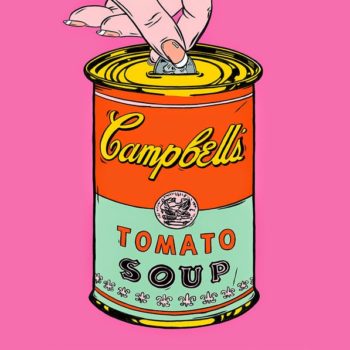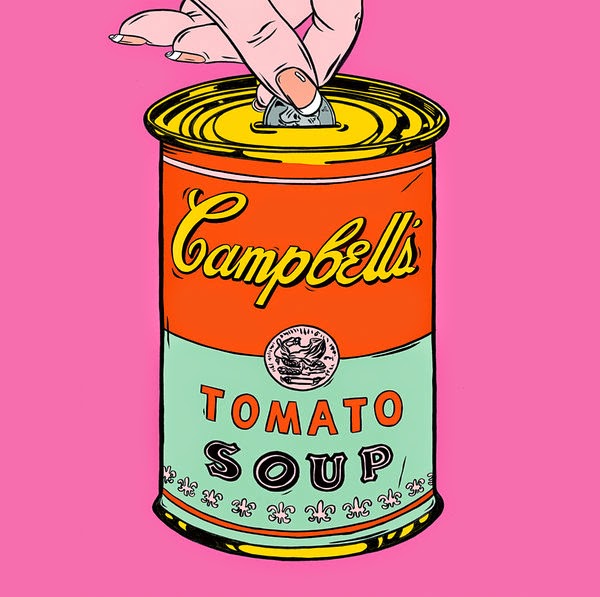
DE CÓMO EL ARTE MUERE
Pequeña lección de economía política
—y cultural—
publicada por The New York Times
05 de febrero
2015

Ilustración de Kelsey Dake
ART FOR MONEY’S SAKE
William Alden
The New York Times Sunday Magazine
03 febrero 2015
You could be forgiven for thinking the boxy structure that opened last November in Long Island City, Queens, with gray-and-white stripes flanking a blue frontispiece, was a bold new art museum. The modern-looking facility, built from the ground up at a cost of $70 million, is set to span 280,000 square feet when an adjacent building opens this spring. The complex will be packed with thousands of works of art, from old masters to contemporary rising stars. But unlike at a museum, few will ever see the works that live inside it.
That’s because the structure is the flagship location of an upstart art-storage company called Uovo. Rather than refurbish an old warehouse, Uovo built from scratch, creating a vault with “Mission: Impossible”-grade security and bespoke technology for cataloging artworks that makes information about them readily available to interested buyers.
Uovo has already leased a vast majority of its available space, a reflection of the incredible demand for these services as the art market booms. Christie’s and Sotheby’s combined sold roughly $14 billion worth of art last year, in record-setting amounts for both auction houses, asa flood of expensive works moved through the market. More than 2,000 works sold for more than $1 million in 2014, compared with about 460 such sales in 2004, according to data from Artnet. In 2013, with the global art market estimated at $65.9 billion, about $16.8 billion was spent on services.
The wealthiest Americans have grown wealthier since the Great Recession, and many are investing their wealth in art. Especially with bonds and other assets offering rock-bottom yields, the art market —where reports of record-high sales now emerge regularly— has an obvious appeal. According to a survey last year by Deloitte and ArtTactic, an art-research firm, 76 percent of art buyers viewed their acquisitions as investments, compared with 53 percent in 2012. And with more collectors viewing art as a financial investment, storage can become an artwork’s permanent fate.
Largely hidden from public view, an ecosystem of service providers has blossomed as Wall Street-style investors and other new buyers have entered the market. These service companies, profiting on the heavy volume of deals while helping more deals take place, include not only art handlers and advisers but also tech start-ups like ArtRank. A sort of Jim Cramer for the fine arts, ArtRank uses an algorithm to place emerging artists into buckets including “buy now,” “sell now” and“liquidate.” Carlos Rivera, co-founder and public face of the company, says that the algorithm, which uses online trends as well as an old-fashioned network of about 40 art professionals around the world, was designed by a financial engineer who still works at a hedge fund. The service is limited to 10 clients, each of whom pays $3,500 a quarter for what they hope will be market-beating insights. It’s no surprise that Rivera, 27, who formerly ran a gallery in Los Angeles, is not popular with artists.
Despite the seemingly prosaic nature of its service, Uovo also encourages speculation in a more subtle way. Everything about the facility seems designed to remove friction from the art market —to turn physical objects into liquid assets. Apart from its private viewing rooms for deal making, which are now common in the storage business, what really sets Uovo apart is its vast database. After each artwork is tagged with a bar code, the company’s technicians use a proprietary app to quickly retrieve detailed information about the pieces, including their precise location and recent movements, says Christopher Wise, executive vicepresident of operations.
Wise says the technology is largely in place for security purposes, to keep track of such valuable investments. (This is not a hypothetical concern. In 2013, a Norman Rockwell painting worth more than $1 million simply vanished from its Queens storage facility, only to be tracked down later in Ohio.) But giving clients and prospective buyers remote access to so much data, while making the business more efficient, also helps make the art more like a tradable unit, able to change hands without even leaving a warehouse. Buyers can use the database in much the same way a hedge funder uses a Bloomberg terminal.
Collectors have not always been so willing to consign their new acquisitions to storage. Near the end of his life, Henry Clay Frick, the 19th-century industrialist, built a mansion on Fifth Avenue in Manhattan to house his art collection. He bought more art to fill up the house, and after his death, it became the site of the Frick Collection museum. In 1945, the oil baron J. Paul Getty bought a seaside home near Malibu that he filled with art, later opening the house periodically to the public. To be sure, these men weren’t inviting the masses into their homes while they were alive —but they did hang their art, which was the fruit of their wealth, not its source.
Enrique Liberman, a lawyer who works with funds that buy art on behalf of wealthy investors, says the art market now “has all the trappings of traditional investment markets in the form of the services provided. “While that may be a slight exaggeration —the art market, after all, remains opaque and unregulated— places like Uovo bring us closer to that reality.
All of this tends to make artists uncomfortable. One prominent artist, who insisted on anonymity to speak freely about the matter, says that the growth of art-storage companies like Uovo demonstrates “something about the way art is functioning, which is less about the artwork saying something or doing something and more about the artwork representing a value.”
He has reason to be alarmed: Not long ago, ArtRank suggested that anyone who owned his work “liquidate.”
———
William Alden is a reporter for The Times’s DealBook.
(Tomado de http://www.nytimes.com/2015/02/08/magazine/art-for-moneys-sake.html?smid=fb-share&_r=2)
